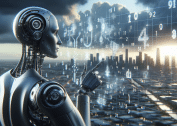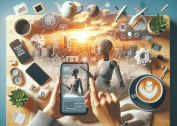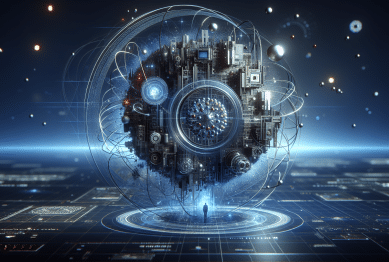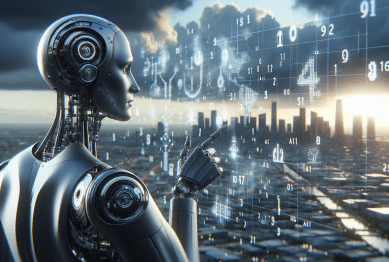Explore fascinating ways artificial intelligence is transforming daily life, from smart homes to health care. This in-depth look at AI’s practical applications uncovers technology trends and future opportunities without overpromising or unnecessary hype.
AI in Smartphones and Personal Devices
Artificial intelligence is already embedded in most smartphones, powering tools that many take for granted. Voice assistants, like those built into mobile operating systems, use AI algorithms to recognize speech with remarkable accuracy. These assistants respond to questions, set reminders, and even manage daily schedules. Beyond simple commands, AI-driven recommendation engines suggest music, news, and apps by analyzing preferences. Each swipe or search refines the system, making devices genuinely personal over time. This adaptive learning brings subtle convenience, often unnoticed until missing.
Security is another area where artificial intelligence excels within mobile devices. Features such as face recognition, fingerprint scanning, and contextual device unlocking all employ sophisticated machine learning models. Data used for biometric authentication never leaves the device in many cases, ensuring user privacy. Even photo organization benefits, as AI sorts images by content, location, and even people, transforming tedious tasks into seamless experiences. As these features evolve, their integration will deepen, further blending technology into daily habits. Everyday users become unwitting participants in this intelligent transformation, reaping benefits almost invisibly.
Behind the scenes, battery management on smartphones often relies on artificial intelligence to optimize energy usage. AI predicts which apps will be used and manages background activity for improved longevity. It even adapts charging cycles to prolong battery health. The same intelligence that helps users navigate their digital lives also keeps devices running efficiently. The result is not just more convenience, but a tangible extension of device lifespan and reliability, achieved through continual automated learning and adaptation (Source: https://www.nist.gov/artificial-intelligence).
Smart Homes: AI at Your Fingertips
The smart home concept is increasingly shaped by artificial intelligence. AI-powered assistants control lighting, temperatures, appliances, and more with simple voice or app commands. These systems learn routines and can anticipate preferences, adjusting thermostats before arrival or dimming lights as evening approaches. AI brings energy savings as well, optimizing heating and cooling cycles with minimal intervention. Users often notice improved comfort without direct attention and can adjust their environment using natural language, making home technology accessible for everyone.
Security in smart homes has advanced with AI-enabled cameras and sensors. These systems don’t just record footage—they analyze real-time video streams to differentiate between strangers, pets, and family members. Unusual movement triggers notifications, while familiar faces are ignored. AI also identifies patterns, alerting residents if routines are disrupted or if potential hazards arise. This security extends beyond the door, monitoring everything from smoke detectors to water leaks, all coordinated from a central hub. The peace of mind comes from knowing that AI is always watching for meaningful change.
Smart kitchen appliances are transforming meal preparation through embedded artificial intelligence. Fridges can track expiration dates, plan recipes, or even reorder groceries automatically. Voice-assistant integration helps users search for recipes, control ovens, or set timers hands-free. The kitchen becomes a connected, flexible workspace where learning algorithms streamline grocery lists and suggest healthier eating patterns. Over time, these smart home features reduce waste and improve nutrition (Source: https://www.energy.gov/eere/buildings/articles/how-smart-home-technology-helps-save-energy).
Artificial Intelligence in Health and Wellness
Health-focused applications increasingly leverage AI for more personal and predictive care. Wearables track heart rate, sleep cycles, and activity levels, generating data that artificial intelligence algorithms analyze to provide tailored insights. Notification systems remind users to move or rest, while predictive analytics detect signs of health problems early. Some fitness apps use AI to craft workout plans or offer virtual coaching, making health guidance feel responsive and individualized. The continuous feedback loop supports preventive wellness and timely intervention.
AI is also reshaping medical diagnostics. Tools analyze symptoms and suggest possible conditions, helping individuals understand when to seek professional care. In clinical settings, artificial intelligence assists with reading x-rays, identifying early indicators of disease, and even predicting patient outcomes. Medical chatbots offer initial advice or help navigate healthcare systems, serving communities where access to doctors may be limited. Each of these applications relies on large pools of data, processed securely and used for decision support rather than final diagnoses (Source: https://www.nih.gov/news-events/nih-research-matters/artificial-intelligence-improves-health-care).
Mental wellness apps are a growing use case for artificial intelligence. They monitor mood, recommend mindfulness activities, and check in on emotional health. AI-driven analysis can spot subtle changes in user responses or engagement, suggesting when additional support might help. By making mental support discreet and proactive, AI helps foster daily well-being and destigmatizes the pursuit of mental health care. These features are designed as helpful tools, not replacements for professionals, keeping the focus on enhancing everyday wellness.
Education: Personalized Learning Experiences
Artificial intelligence is making education more personalized. Adaptive learning platforms use AI to assess student strengths and weaknesses, then tailor lessons accordingly. No two students receive the exact same material or pace. The system adjusts based on responses, encouraging mastery of concepts instead of memorization. With virtual tutors and AI-powered feedback, learners get real-time insight into progress and tailored recommendations for improvement. This continuous adaptation has the potential to close learning gaps and support self-paced study for people of all ages.
Language learning apps harness artificial intelligence in impressive ways. Speech recognition, instant translations, and adaptive practice all rely on complex algorithms. As users advance, the software suggests targeted vocabulary or grammar exercises, using mistakes as data to refine the learning journey. The approach makes language acquisition more interactive and efficient, matching traditional instruction with the flexibility of digital environments. AI-driven assessment supports learners by tracking improvement transparently and constructively, without pressure or penalty (Source: https://www.ed.gov/news/speeches/artificial-intelligence-education).
Educational accessibility receives a boost from AI, with tools for students with disabilities. Text-to-speech, real-time captioning, and adaptive testing remove traditional barriers, helping all students participate fully. AI support extends to administrative tasks, such as scheduling or tracking attendance, easing the burden on teachers. The inclusion of artificial intelligence in education promises more equitable opportunities for learners worldwide, as institutions and software developers integrate inclusive design from the start.
AI and Environmental Sustainability Efforts
Artificial intelligence contributes to environmental sustainability, particularly in energy management. Smart meters, grid optimizations, and home energy apps use AI to collect data and recommend efficiency improvements. Buildings automatically adjust usage patterns in response to weather, occupancy, or price signals, significantly reducing waste. Cities leverage these systems for wider benefits, coordinating public utilities and transit for greener outcomes (Source: https://www.scientificamerican.com/article/ai-and-the-environment-how-smart-tech-can-save-the-world/).
Conservation efforts are strengthened by artificial intelligence, from endangered species tracking to forest fire detection. Drones and satellites equipped with AI analyze landscape images, spotting illegal activity or natural disasters earlier than human monitors could. Researchers also use AI to study climate impacts and plan reforestation projects more effectively, using predictive models that factor in countless variables.
On the individual level, AI-driven apps help users reduce their carbon footprint. Suggestions on eco-friendly transportation, energy-saving behaviors, and sustainable shopping guide more conscious decisions. Artificial intelligence turns overwhelming sustainability data into usable everyday insights. As more tools emerge, the impact of AI on global and personal sustainability continues to expand.
Ethical Considerations and Responsible AI
Ethics remain central as artificial intelligence becomes common in daily life. Issues such as privacy, bias, and transparency shape how systems are designed and used. Developers are encouraged to explain how AI makes decisions and to minimize reliance on sensitive user data. Robust security ensures personal information remains confidential, especially in health care, education, and home environments. Consumers and policymakers alike must continue to ask how artificial intelligence is regulated and monitored.
Responsible AI also means ensuring inclusivity. Algorithms can unintentionally reinforce existing inequalities if trained on unbalanced data. It is crucial to audit AI models for fairness, seeking to avoid discrimination in applications such as job recruitment or banking. Collaboration between governments, academia, and private industry helps set standards and share effective practices (Source: https://www.brookings.edu/articles/principles-for-responsible-artificial-intelligence-in-society/).
Education about AI ethics should also reach the public. Understanding both the advantages and limitations of artificial intelligence helps users make informed choices. As AI becomes integral to households and workplaces, transparent conversations ensure technology is applied responsibly and equitably for all.
References
1. National Institute of Standards and Technology. (n.d.). Artificial Intelligence. Retrieved from https://www.nist.gov/artificial-intelligence
2. Office of Energy Efficiency & Renewable Energy. (n.d.). How Smart Home Technology Helps Save Energy. Retrieved from https://www.energy.gov/eere/buildings/articles/how-smart-home-technology-helps-save-energy
3. National Institutes of Health. (n.d.). Artificial Intelligence Improves Health Care. Retrieved from https://www.nih.gov/news-events/nih-research-matters/artificial-intelligence-improves-health-care
4. U.S. Department of Education. (n.d.). Artificial Intelligence in Education. Retrieved from https://www.ed.gov/news/speeches/artificial-intelligence-education
5. Scientific American. (n.d.). AI and the Environment: How Smart Tech Can Save the World. Retrieved from https://www.scientificamerican.com/article/ai-and-the-environment-how-smart-tech-can-save-the-world/
6. Brookings Institution. (n.d.). Principles for Responsible Artificial Intelligence in Society. Retrieved from https://www.brookings.edu/articles/principles-for-responsible-artificial-intelligence-in-society/









